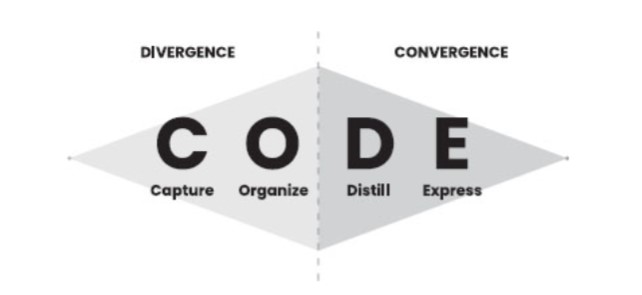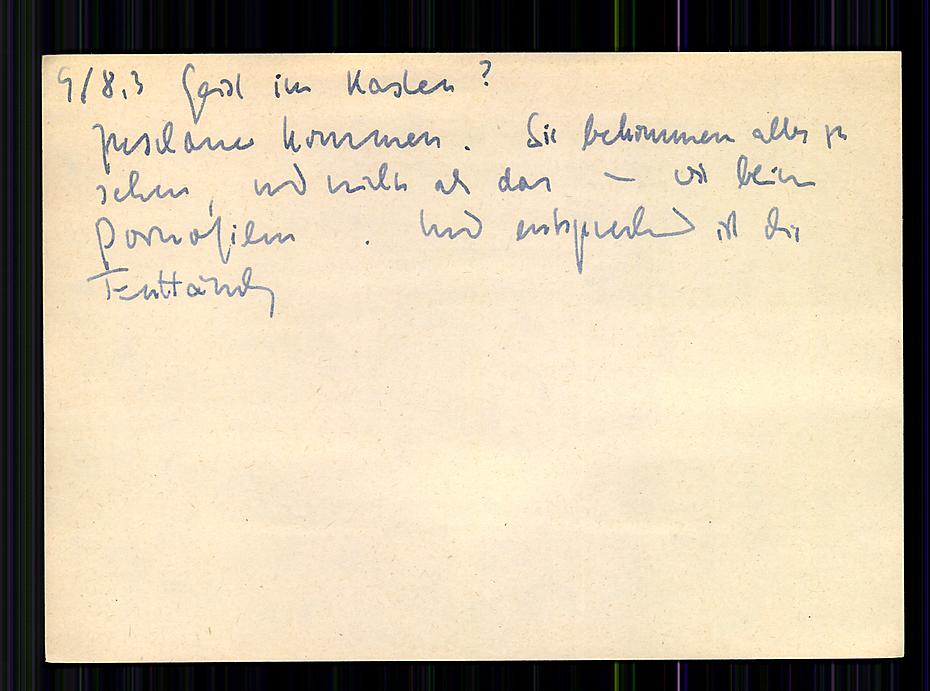This episode's transcript was produced by an AI. If you notice any errors, please get in touch.
puts the work on the reader/user rather than the producer
This episode's transcript was produced by an AI. If you notice any errors, please get in touch.
puts the work on the reader/user rather than the producer
With more notes, you have more to work with and what a learner does with this content is where the more significant benefits are produced.
Yes, this by itself, but note that it also requires that one put in additional work—something many don't want to do in the first place.
In Re: to folgezettel or not? in an unlogged chat:
Zettelkasten (slips) or not (commonplaces, notebooks, paper, files, other), you're going to have a variety of related ideas which you'll juxtapose, especially if you're regularly writing. Those who practice folgezettel are putting in some of the work/heavy lifting from the start versus those who don't and are leaving the work until some later point closer to composition. Folgezettel also helps to encourage the emergence of ideas, but requires work to do so. This doesn't mean that this emergence or new ideas may not arrive without Folgezettel and/or Zettelkasten, but one needs to have some process or affordances which help to foster them. Victor Margolin's process put more of his work on the back end in comparison to Luhmann, but his version obviously works all the same. See: https://www.youtube.com/watch?v=Kxyy0THLfuI
This reminded me of Robert Greene’s definition of creativity, which is that creativity is a function of putting in lots of tedious work. “If you put a lot of hours into thinking and researching and reading,” Robert says, “hour after hour—a very tedious process—creativity will come to you.”
Robert Green's definition of creativity sounds like it's related to diffuse thinking processes. read: https://billyoppenheimer.com/august-14-2022/
Often note taking, and reviewing over those notes is more explicit in form for creating new ideas.
Come back to explore these.
If we overlay the four steps of CODE onto the model ofdivergence and convergence, we arrive at a powerful template forthe creative process in our time.
The way that Tiago Forte overlaps the idea of C.O.D.E. (capture/collect, organize, distill, express) with the divergence/convergence model points out some primary differences of his system and that of some of the more refined methods of maintaining a zettelkasten.
 <small>Overlapping ideas of C.O.D.E. and divergence/convergence from Tiago Forte's book Building a Second Brain (Atria Books, 2022) </small>
<small>Overlapping ideas of C.O.D.E. and divergence/convergence from Tiago Forte's book Building a Second Brain (Atria Books, 2022) </small>
Forte's focus on organizing is dedicated solely on to putting things into folders, which is a light touch way of indexing them. However it only indexes them on one axis—that of the folder into which they're being placed. This precludes them from being indexed on a variety of other axes from the start to other places where they might also be used in the future. His method requires more additional work and effort to revisit and re-arrange (move them into other folders) or index them later.
Most historical commonplacing and zettelkasten techniques place a heavier emphasis on indexing pieces as they're collected.
Commonplacing creates more work on the user between organizing and distilling because they're more dependent on their memory of the user or depending on the regular re-reading and revisiting of pieces one may have a memory of existence. Most commonplacing methods (particularly the older historic forms of collecting and excerpting sententiae) also doesn't focus or rely on one writing out their own ideas in larger form as one goes along, so generally here there is a larger amount of work at the expression stage.
Zettelkasten techniques as imagined by Luhmann and Ahrens smooth the process between organization and distillation by creating tacit links between ideas. This additional piece of the process makes distillation far easier because the linking work has been done along the way, so one only need edit out ideas that don't add to the overall argument or piece. All that remains is light editing.
Ahrens' instantiation of the method also focuses on writing out and summarizing other's ideas in one's own words for later convenient reuse. This idea is also seen in Bruce Ballenger's The Curious Researcher as a means of both sensemaking and reuse, though none of the organizational indexing or idea linking seem to be found there.
This also fits into the diamond shape that Forte provides as the height along the vertical can stand in as a proxy for the equivalent amount of work that is required during the overall process.
This shape could be reframed for a refined zettelkasten method as an indication of work
Forte's diamond shape provided gives a visual representation of the overall process of the divergence and convergence.
But what if we change that shape to indicate the amount of work that is required along the steps of the process?!
Here, we might expect the diamond to relatively accurately reflect the amounts of work along the path.
If this is the case, then what might the relative workload look like for a refined zettelkasten? First we'll need to move the express portion between capture and organize where it more naturally sits, at least in Ahren's instantiation of the method. While this does take a discrete small amount of work and time for the note taker, it pays off in the long run as one intends from the start to reuse this work. It also pays further dividends as it dramatically increases one's understanding of the material that is being collected, particularly when conjoined to the organization portion which actively links this knowledge into one's broader world view based on their notes. For the moment, we'll neglect the benefits of comparison of conjoined ideas which may reveal flaws in our thinking and reasoning or the benefits of new questions and ideas which may arise from this juxtaposition.

This sketch could be refined a bit, but overall it shows that frontloading the work has the effect of dramatically increasing the efficiency and productivity for a particular piece of work.
Note that when compounded over a lifetime's work, this diagram also neglects the productivity increase over being able to revisit old work and re-using it for multiple different types of work or projects where there is potential overlap, not to mention the combinatorial possibilities.
--
It could be useful to better and more carefully plot out the amounts of time, work/effort for these methods (based on practical experience) and then regraph the resulting power inputs against each other to come up with a better picture of the efficiency gains.
Is some of the reason that people are against zettelkasten methods that they don't see the immediate gains in return for the upfront work, and thus abandon the process? Is this a form of misinterpreted-effort hypothesis at work? It can also be compounded at not being able to see the compounding effects of the upfront work.
What does research indicate about how people are able to predict compounding effects over time in areas like money/finance? What might this indicate here? Humans definitely have issues seeing and reacting to probabilities in this same manner, so one might expect the same intellectual blindness based on system 1 vs. system 2.
Given that indexing things, especially digitally, requires so little work and effort upfront, it should be done at the time of collection.
I'll admit that it only took a moment to read this highlighted sentence and look at the related diagram, but the amount of material I was able to draw out of it by reframing it, thinking about it, having my own thoughts and ideas against it, and then innovating based upon it was incredibly fruitful in terms of better differentiating amongst a variety of note taking and sense making frameworks.
For me, this is a great example of what reading with a pen in hand, rephrasing, extending, and linking to other ideas can accomplish.
The second way that people use their Second Brain is to connectideas together. Their Second Brain evolves from being primarily amemory tool to becoming a thinking tool. A piece of advice from amentor comes in handy as they encounter a similar situation on adifferent team. An illuminating metaphor from a book finds its wayinto a presentation they’re delivering. The ideas they’ve capturedbegin gravitating toward each other and cross-pollinating.
Missing from this description is the work that is involved in revisting, re-reading, and interacting with your notes. This is not an easy process, but this paragraph belies the work involved and makes it seem "magical" with the use of the words 'illuminating', 'gravitating', 'cross-pollinating' which are all external processes or forces that don't require work from the individual.
If we put effort into the attempt of retrievinginformation, we are much more likely to remember it in the long run,even if we fail to retrieve it without help in the end (Roediger andKarpicke 2006)
Learning requires effort, because we have to think to understandand we need to actively retrieve old knowledge to convince ourbrains to connect it with new ideas as cues. To understand howgroundbreaking this idea is, it helps to remember how much effortteachers still put into the attempt to make learning easier for theirstudents by prearranging information, sorting it into modules,categories and themes. By doing that, they achieve the opposite ofwhat they intend to do. They make it harder for the student to learnbecause they set everything up for reviewing, taking away theopportunity to build meaningful connections and to make sense ofsomething by translating it into one’s own language. It is like fastfood: It is neither nutritious nor very enjoyable, it is just convenient
Some of the effort that teachers put into their educational resources in an attempt to make learning faster and more efficient is actually taking away the actual learning opportunities of the students to sort, arrange, and make meaningful connections between the knowledge and to their own prior knowledge bases.
In mathematics, rather than showing a handful of methods for solving a problem, the teacher might help students to explore those problem solving spaces first and then assist them into creating these algorithms. I can't help but think about Inventional Geometry by William George Spencer that is structured this way. The teacher has created a broader super-structure of problems, but leaves it largely to the student to do the majority of the work.
A coach is not there to do the work,but to show us how to use our time and effort in the most effectiveway.
Much as coaches help their athletes become better, teachers are there to help students use their time and work efforts in the most effective ways.
The card index appeared to be simply what it was: a wooden box for paper slips. On one of these file cards, Luhmann once summarized his own reflections on just such an experience: ‘People come, they see everything and nothing more than that, just like in porn movies; consequently, they leave disappointed’ (Figure 1).8
- Cf. Schmidt, ‘Luhmanns Zettelkasten’, 7. The heading of this file card is formulated in form of a question: ‘Geist im Kasten?’ (‘Does Spirit hide in the filing cabinet?’). Obviously, the answer is no. Many thanks to Johannes Schmidt for providing the image of this file card.
In a zettel in his system entitled "Does Spirit hide in the filing cabinet", Niklas Luhmann wrote the note: "People come, they see everything and nothing more than that, just like in porn movies; consequently, they leave disappointed." This is a telling story about the simplicity of the idea of a slip box (zettelkasten, card catalog, or commonplace book).

It's also a testament to the fact that the value of it is in the upfront work that is required in making valuable notes and linking them. Many end up trying out the simple looking system and then wonder why it isn't working for them. The answer is that they're not working for it.